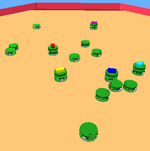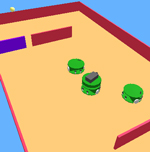
Last Updated: Oct 14, 2004.
Send your feedback to
Low Kian Hsiang.






 Last Updated: Oct 14, 2004. Send your feedback to Low Kian Hsiang. |






|
| PROJECTS > |
|
||||||||
| PEOPLE > |
Faculty
|
||||||||
| RESOURCES > | |||||||||
| ___________________________________________________________________________ | |||||||||
| DISTRIBUTED LAYERED ARCHITECTURE FOR SELF-ORGANIZATION OF MOBILE SENSOR NETWORKS |
|
PROBLEM STATEMENT
One of the fundamental issues that arises in a sensor network is coverage. Traditionally, network coverage is maximized by determining the optimal placement of static sensors in a centralized manner, which can be related to the class of art gallery problems. However, recent investigations in sensor network mobility reveal that mobile sensors can self-organize to provide better coverage than static placement. Existing applications have only utilized uninformed mobility (i.e., random motion or patrol). In contrast, our work here focuses on informed, intelligent mobility to further improve coverage. Our network coverage problem is motivated by the following constraints that discourage static sensor placement or uninformed mobility: a) no prior information about the exact target locations, population densities or motion pattern, b) limited sensory range, and c) very large area to be observed. All these conditions may cause the sensors to be unable to cover the entire region of interest. Hence, fixed sensor locations or uninformed mobility will not be adequate in general. Rather, the sensors have to move dynamically in response to the motion and distribution of targets and other sensors to maximize coverage. Inspired by robotics, the above problem may be regarded as that of low-level motion control to coordinate the sensors' target tracking movements in the continuous workspace. Alternatively, it can be cast as a high-level task allocation problem by segmenting the workspace into discrete regions such that each region is assigned a group or coalition of sensors to track the targets within. PROPOSED METHOD This work presents a reactive layered multi-robot architecture for distributed mobile sensor network coverage in complex, dynamic environments. At the lower layer, each robot uses a reactive motion control strategy known as Cooperative Extended Kohonen Maps to coordinate their target tracking within a region without the need of communication. This strategy is also responsible for obstacle avoidance, robot separation to minimize task interference, and navigation between regions via beacons or checkpoints plotted by a motion planner. At the higher layer, the robots use a dynamic ant-based task allocation scheme to cooperatively self-organize their coalitions in a decentralized manner according to the target distributions across the regions. This scheme addresses the following issues, which distinguish it from the other task allocation mechanisms: Task Allocation for Multi-Robot Tasks: Existing algorithms (e.g., auction-and behavior-based) assume a multi-robot task can be partitioned into single-robot tasks. But this may not be always possible or the multi-robot task can be more efficiently performed by coalitions of robots. Coalition Formation for Minimalist Robots: Existing coalition formation schemes require complex planning, explicit negotiation, and precise estimation of coalitional cost. Hence, they do not perform well in dynamic, real-time scenarios. Cooperation of Resource-Limited Robots: Robots with limited communication and sensing capabilities (i.e., partial observability) can only obtain local, uncertain information of the dynamic environment. With limited computational power, their cooperative strategies cannot involve complex planning or negotiations. VIDEOS Coverage of 30 targets (green) with 15 ant robots (white)
PUBLICATIONS
|
|
CONTINUOUS-SPACED
ACTION
SELECTION
FOR
SINGLE-
AND
MULTI-ROBOT
TASKS
WITH COOPERATIVE EXTENDED KOHONEN MAPS |
|
PROBLEM STATEMENT
A central issue in the design of behavior-based control architectures for autonomous mobile robots is the formulation of effective mechanisms to coordinate the behaviors. These mechanisms determine the policy of conflict resolution between behaviors, which involves behavioral cooperation and competition to select the most appropriate action. The actions are selected so as to optimize the achievement of the goals or behavioral objectives. Developing such an action selection methodology is non-trivial due to realistic constraints such as environmental complexity and unpredictability, and resource limitations, which include computational and cognitive capabilities of the robot, incomplete knowledge of the environment, and time constraints. As a result, action selection can never be absolutely optimal. Given these constraints, the action selection scheme should be able to choose actions that are good enough to satisfy multiple concurrent, possibly conflicting, behavioral objectives. PROPOSED METHOD Our motivation of the action selection mechanism is to develop a motion control strategy for autonomous non-holonomic mobile robots that can perform distributed multi-robot surveillance in unknown, dynamic, complex, and unpredictable environments. By implementing the action selection framework using an assemblage of self-organizing neural networks, it induces the following key features that significantly enhance the agent's action selection capability: self-organization of continuous state and action spaces to provide smooth, efficient and fine motion control, and action selection via the cooperation and competition of Extended Kohonen Maps to achieve more complex motion tasks: (1) negotiation of unforeseen concave and narrowly spaced obstacles, and (2) cooperative tracking of multiple mobile targets by a team of robots. Qualitative and quantitative comparisons for single- and multi-robot tasks show that our framework can provide better action selection than do potential fields method. VIDEOS PUBLICATIONS
|
| INTEGRATED ROBOT PLANNING AND CONTROL WITH EXTENDED KOHONEN MAPS |
|
PROBLEM STATEMENT
Robot motion research has proceeded along two separate directions: high-level deliberative planning and low-level reactive control. Deliberative planning uses a world model to generate an optimal sequence of collision-free actions that can achieve a globally specified goal in a complex static environment. However, in a dynamic environment, unforeseen obstacles may obstruct the action sequence, and replanning to react to these situations can be too computationally expensive. On the other hand, reactive control directly couples sensed data to appropriate actions. It allows the robot to respond robustly and timely to unexpected obstacles and environmental changes but may be trapped by them. PROPOSED METHOD The problem of goal-directed, collision-free motion in a complex, unpredictable environment can be solved by tightly integrating high-level deliberative planning with low-level reactive control. This work presents two such architectures for a nonholonomic mobile robot. To achieve real-time performance, reactive control capabilities have to be fully realized so that the deliberative planner can be simplified. These architectures are enriched with reactive target reaching and obstacle avoidance modules. Their target reaching modules use indirect-mapping Extended Kohonen Map to provide finer and smoother motion control than direct-mapping methods. While one architecture fuses these modules indirectly via command fusion, the other one couples them directly using cooperative Extended Kohonen Maps, enabling the robot to negotiate unforeseen concave obstacles. The planner for both architectures use a slippery cells technique to decompose the free workspace into fewer cells, thus reducing search time. Any two points in the cell can still be traversed by reactive motion. VIDEOS
PUBLICATIONS
|
| ___________________________________________________________________________ |
|
This document, chimerobotics.html, has been accessed 460 times since 25-Jun-24 11:57:13 +08.
This is the 3rd time it has been accessed today.
A total of 250 different hosts have accessed this document in the last 349 days; your host, 216.73.216.65, has accessed it 1 times. If you're interested, complete statistics for this document are also available, including breakdowns by top-level domain, host name, and date.
|